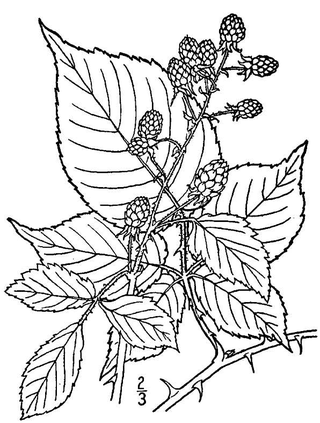Rubus allegheniensis
Berry and plant From Wikipedia, the free encyclopedia
Rubus allegheniensis is a North American species of highbush blackberry in Section Alleghenienses of the genus Rubus, a member of the rose family.[6] It is the most common and widespread highbush blackberry in eastern and central North America. It is commonly known as Allegheny blackberry.[7]
| Rubus allegheniensis | |
|---|---|
 | |
| Allegheny blackberry 1913 illustration[1] | |
| Scientific classification | |
| Kingdom: | Plantae |
| Clade: | Tracheophytes |
| Clade: | Angiosperms |
| Clade: | Eudicots |
| Clade: | Rosids |
| Order: | Rosales |
| Family: | Rosaceae |
| Genus: | Rubus |
| Subgenus: | Rubus subg. Rubus |
| Species: | R. allegheniensis |
| Binomial name | |
| Rubus allegheniensis | |
| Synonyms[3][4][5] | |
|
Synonymy
| |
Description
The characteristics of Rubus allegheniensis can be highly variable.[8] It is an erect bramble, typically 1.5 metres (5 feet) but occasionally rarely over 2.4 m (8 ft) high, with single shrubs approaching 2.4 m or more in breadth, although it usually forms dense thickets of many plants. The leaves are alternate, compound, ovoid, and have toothed edges.[8][9] The canes have many prickles, with white, 5-petal, 19-millimetre (3⁄4-inch) flowers in late spring and glossy, deep-violet to black, aggregate fruit in late summer.[8] It is shade intolerant.[10]
- Leaves
- Fruits
- Flowers
Distribution and habitat
R. allegheniensis is very common throughout forests in eastern and central North America. It is also naturalized in a few locations in California and British Columbia.[7][11]
Uses
The berries are edible and nutritious. They can be eaten raw or cooked into various treats, including pies, cobblers, muffins, jellies, and jams.[8]
Ecology
Summarize
Perspective
Many mammals eat the fruit, including elk, foxes, American black bears, rabbits, raccoons, opossums, squirrels, mice, and chipmunks, and deer will browse the young canes. Blackberries are also an important food source for many species of birds. The mammals and birds that eat the fruit then disperse the seed in their droppings, enabling the plant to spread to new locations. A wide variety of native bees, butterflies, beetles, flies, ants, wasps, and other insects are attracted to the nectar and pollen of the flowers, and caterpillars, grasshoppers, beetles eat the leaves. Birds and small mammals use the thickets formed by the canes for shelter.[8]
The presence of the species influences the dynamics of the understory vegetation of many forests in the eastern United States. An abundance of R. allegheniensis encourages new tree seedlings. Where the effects of herbivorous animals (such as whitetail deer) reduce the abundance of Allegheny blackberry, a competitor, Sitobolium punctilobulum (hay-scented fern), takes over; where S. punctilobulum becomes common, the growth of tree seedlings is restricted.[12]
Concentrations of R. allegheniensis increase greatly after events that destroy taller shrubs and trees and thus permit more light into the understory, such as fires or widespread blowdown.[10][13] These populations often decline in later years as the tree seedlings sheltered by the blackberry canes grow and reduce the amount of light reaching the lower levels.[10]
References
External links
Wikiwand - on
Seamless Wikipedia browsing. On steroids.




